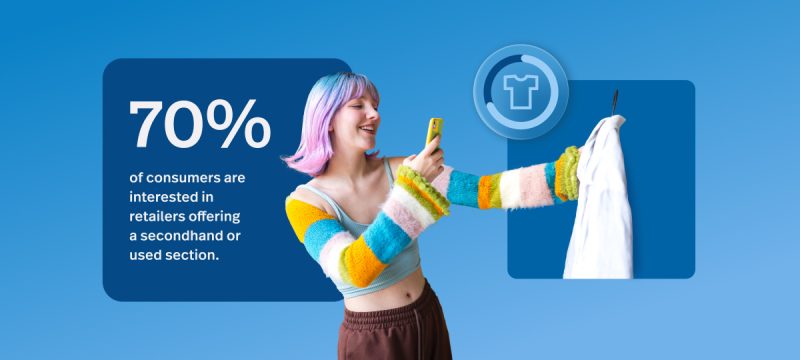
As Earth Day approaches, it’s the perfect time to reflect on the state of sustainable fashion. Despite the fashion industry’s significant environmental impact, consumers are increasingly seeking eco-friendly options—pushing sustainable brands to stay true to their mission and continue innovating.
In this article, we’ll explore some of the most relevant trends shaping sustainable fashion today:
- Circular and slow fashion
- The rise of secondhand retail
- Innovations in sustainable materials
- Ethical production and transparency
- Smart inventory management
What is sustainable fashion?
Sustainable fashion is about minimizing social and environmental harm while promoting a circular economy. More than just a buzzword, it represents a fundamental shift in how businesses operate, prioritizing long-term sustainability over short-term profits.
It’s no surprise that in today’s cultural landscape, consumers are actively seeking brands they can trust. In 2024, the global sustainable fashion market was valued at $9.22 billion and is projected to reach $20.84 billion by 2033. This is no passing trend—consumers have made it clear: sustainability matters.
Make your business more sustainable
Optimize work orders, streamline inventory and create a circular economy with Lightspeed.
Circular and slow fashion: the enemy of planned obsolescence
You can’t talk about sustainable fashion without addressing circular fashion. The fashion industry generates an alarming amount of waste, and circular fashion aims to combat this by creating a system that values items even at the end of their life cycle.
A circular business starts with better products. Brands that follow circular fashion principles design items to be well-loved, repaired, biodegradable and eventually recyclable.
While implementing a circular fashion model may seem daunting, the benefits are substantial. According to Harvard Business Review, businesses can significantly cut production costs by reusing materials and offering take-back programs. These programs not only build trust but also deepen customer engagement, fostering long-term loyalty.
Beyond cost savings, circular fashion strengthens brand image, giving businesses a competitive edge over those less committed to environmental responsibility. Adopting these principles also ensures long-term stability, keeping businesses ahead of evolving environmental regulations.
Reducing consumption is a core pillar of slow fashion—a broad movement that emphasizes supply chain integrity and encourages consumers to invest in timeless, high-quality pieces. Today, the focus is on maximizing product lifespan. This shift presents a business opportunity: many brands, including Patagonia, Nudie Jeans, Veja and Levi’s, offer in-store repair services, encouraging customers to maintain their items rather than replace them. Lightspeed’s service order feature in Retail POS supports this by enabling retailers to offer tune-ups, cleaning, rentals, and repairs—streamlining workflows and reducing the steps needed to manage service sales.
Another key element of circular and slow fashion is clothing rentals. For those hesitant to commit to buying, the clothing rental market is booming—projected to grow by $1.16 billion from 2025 to 2029. As more companies embrace rental-focused models, consumers gain access to high-quality fashion without the full price tag—helping curb fast fashion’s impact.
Resale, thrift, consignment, vintage: the secondhand industry is thriving
According to a study by ThredUp, the secondhand apparel market is expanding, expected to reach $350 billion by 2028—growing three times faster than the global apparel market. The study also found that sustainable fashion retailers are increasingly incorporating resale into their business strategies, with 94% of retail executives reporting that their customers are already participating in resale, an all-time high. Lightspeed’s State of Retail Report shows that 70% of consumers are interested in retailers offering a secondhand or used section, either in-store or online.

Several retailers have also started blending new and secondhand clothing in their stores to meet the growing demand for sustainable fashion. Kids’ clothing brand Hanna Andersson recently launched Hanna-Me-Downs, an initiative that allows customers to buy and sell pre-owned Hanna items. Sellers can choose to receive cash or store credit, encouraging a circular shopping model.
Lightspeed helps secondhand retailers like Goodwill standardize pricing, improving efficiency and boosting ROI.
Beyond just the products on the shelves, retailers are taking secondhand to the next level by sourcing store displays, decor and furniture from pre-owned materials. Not only does this help cut costs, but it also reinforces a company’s values and commitment to sustainability.
An unexpected player in the secondhand market? Artificial intelligence. AI is now helping curate outfits, often inspired by celebrity or high-end styles, both in-store and online. Shoppers can upload images of specific outfits they’re looking for, and style chatbots or virtual assistants will suggest secondhand alternatives.
The fashion recipe: how does sustainable fashion get made?
High-quality and sustainable materials go hand in hand, and eco-conscious retailers continue to innovate with fabrics that are gentler on the planet. Sustainable fashion starts with eco-friendly materials—fibers that are renewable, biodegradable or recycled, such as organic cotton, hemp and bamboo. Organic cotton is grown without synthetic pesticides, helping maintain soil health. Hemp thrives with minimal water, a crucial benefit as water scarcity becomes a growing concern. It also produces a breathable, durable fabric. Bamboo requires little water as well, with the added bonus of being exceptionally soft (hello, cozy sheets!).
The vegan fashion market is another space to watch, with projections indicating nearly 8% growth by 2032. Vegan fashion extends beyond leather, including everything from footwear to clothing and accessories. Consumers are increasingly seeking cruelty-free products, especially as more celebrities and influencers embrace veganism and plant-based lifestyles.
Ethical production: transparency across the supply chain
With the rise of the conscious consumer movement, sustainable brands are under greater scrutiny than ever. To be recognized as a brand that upholds ethical production and transparency, businesses must ensure safe working conditions at every stage of the supply chain, fair wages for workers and reasonable working hours.
Some clothing companies, like Everlane, have made social responsibility a core part of their mission. They strive to dedicate significant time and resources to finding suppliers that meet their high ethical standards. To further their commitment to sustainability, they have created a transparency pledge and maintain a dedicated section on their website detailing the practices of each of their factories.

At the bottom of every product page, Everlane includes a pricing breakdown, illustrating where costs come from and why an item is priced the way it is—reinforcing their mission of transparency.
Smart inventory management: staying on top of your stock and reducing waste
Another key component of sustainable fashion is maintaining control of your inventory. Beyond using environmentally responsible, high-quality materials that promote longevity, ordering the right amount of product is crucial for an eco-conscious model. This sets sustainable fashion retailers apart from competitors—not only does it reduce waste and minimize environmental impact, but it also cuts costs and saves time.
Lightspeed excels in in-depth inventory management, streamlining the process from start to finish. Staying on top of your inventory means having full oversight and control of your stock so you can avoid over-ordering merchandise. This automated inventory management system uses advanced software and technology to monitor stock levels in real time, helping you track inventory and manage carrying costs with precision. We also support a just-in-time (JIT) inventory system, allowing you to order stock on demand and prevent excess inventory, which can ultimately reduce waste and shrink your environmental footprint.
And finally, you’d be hard-pressed to find a successful sustainable fashion retailer that doesn’t deeply understand their customers. By using Lightspeed’s insight tools, retailers can leverage sales data, track business trends and receive important alerts—all while gaining real-time insights into customer habits and inventory levels. This empowers them to make data-driven decisions that drive sustainability and long-term success.
Threading it all together: a recap on sustainable fashion trends
The great thing about sustainable fashion trends is that they come with a range of benefits. As consumers have become more aware of fast fashion’s impact, these changes have become essential to running a successful business. The best retailers find ways to align economic decisions with environmental responsibility. Whether it’s through a circular or slow fashion approach, incorporating secondhand options, carefully selecting materials, ensuring transparency across the supply chain or smart inventory management, sustainability can help businesses save money while standing out in their markets.
Lightspeed offers a range of products that help businesses thrive in the sustainable fashion industry. From order features that facilitate rentals and repairs to paperless receipts and digital inventory tools that reduce waste, there’s plenty to explore. Watch a demo to see how it works.
FAQs about sustainable fashion
What is sustainable fashion?
Sustainable fashion is a movement toward designing, producing and consuming clothing in ways that reduce environmental impact and promote ethical practices. It focuses on using eco-friendly materials, minimizing waste, embracing circular models like resale and rental and ensuring fair labor conditions—creating a fashion industry that’s better for both people and the planet.
What are current sustainable fashion trends?
Key trends include circular fashion through resale, rental and repair, the growing demand for secondhand shopping and innovations in eco-friendly materials. Consumers also expect brands to be more transparent, pushing businesses to adopt ethical sourcing and responsible production.
How does Lightspeed help fashion retailers be sustainable?
Lightspeed helps retailers reduce waste, optimize inventory and embrace circular fashion. Its POS system supports rentals, repairs and resale, while real-time inventory management prevents overproduction. Committed to sustainability, Lightspeed continually works to reduce its own footprint while helping businesses do the same.

News you care about. Tips you can use.
Everything your business needs to grow, delivered straight to your inbox.


